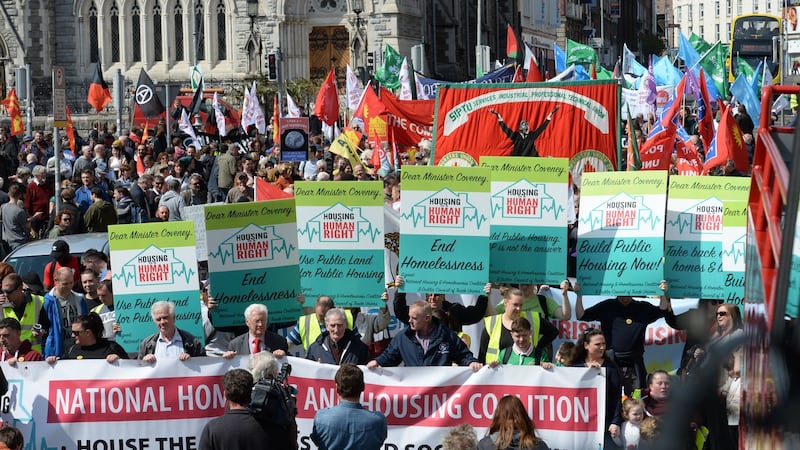There’s a notion that should be instantly dispatched to the annals of wishful thinking: that the Government will, one of these days, do something significant to address the housing crisis.
It assumes that the colossal spike and collapse in property prices that drove the State to the point of bankruptcy in 2008/2009 and the now seemingly endless headlines about soaring prices and “generation rent” has prompted a rethink about how we deliver housing in this country. It hasn’t.
The Government remains ideologically wedded to the idea that the market is the most efficient model for dealing with the State’s housing needs, and by extension opposed to the type of large-scale social housing projects we’ve had in the past. The crash has only served to harden its stance.
Since coming to power in 2011, it has presided over the lowest social housing build in the State’s history, building just 1,300 units in its first five years in office, culminating in a record low of 75 in 2015.
These build rates would have been unthinkable even to the penurious Irish administrations of the 1950s. In 1975, for instance, local authorities built 8,794 social housing units, while the private sector built 18,098 homes.
Even the social housing element of the Government's flagship Rebuilding Ireland strategy, which promises 47,000 units by 2021, is entirely predicated on the private sector.
The bulk of the units (32,000) will come from what the Department of Housing dubiously calls “social housing solutions”, which is a euphemism for private sector rentals.
A further 4,700 units will be delivered via the Part V planning regulations, which require developers to allocate 10 per cent of their estates for use as social housing.
Rehabilitation of the banks
Since the crash the Government has had two overriding objectives; the rehabilitation of the banks, necessary to restore the sovereign’s credit rating and allow the Government borrow on international markets; and the successful execution of its Nama plan to deal with bad loans removed from the banks’ balance sheets.
Both these aims have required the reinflating of property prices.
A major State intervention in the housing market to address the supply deficit and the affordability gap might have worked against this, just like more pointed action on variable mortgage rates, while politically popular, would have delayed the banks’ return to profitability.
The big beneficiaries of the Government’s policy have been the banks, developers and, increasingly, international capital and vulture fund investors who have bought up significant chunks of the Irish real estate market since the crash.

Having been established in 2014, Ires Reit (Irish Residential Properties Real Estate Investment Trust) has already amassed a portfolio of nearly 2,400 apartments. Last year it told shareholders that a “deep imbalance between demand and supply in Dublin’s housing market” meant the firm’s profit outlook was “very positive”.
Similarly, US real-estate firm Kennedy Wilson, which controls €1 billion of property assets here, recently described Dublin as "the most attractive property market in Europe".
Investors
Blaming investors for crowding out conventional buyers is, however, too simplistic. With the Government essentially vacating any meaningful role in the supply of affordable housing, investors are the only ones who will deliver rental accommodation for a growing proportion of people who can’t afford to buy.
The idea that the Central Bank’s mortgage restrictions could restrain house-price inflation over the longer term is now also in question.
While the rules initially prevented some people from buying, causing a temporary slowdown in the market, these buyers were simply pushed into renting, which has driven up rents.
This has enticed more rent-seeking investors into the market, a process that has triggered a further surge in house-price inflation, completing a not so virtuous circle at the heart of the Irish property market
Since the 1980s successive Irish governments have moved away from funding social housing projects, deeming the private market a more efficient model for the delivery of housing.
The aversion to State intervention can be traced back to the 1980s when the Irish economy stagnated and there was a consensus around the need for budgetary tightening, embodied in the so called "Tallaght Strategy", which slashed local authority budgets for social housing, a process that was enabled by mass emigration.
The ideology was also part of a wider international shift away from state intervention toward privatisation and deregulation, now loosely referred to as neoliberalism.
Financial asset
In the property sector this process ran in tandem with what sociologists refer to as the hyper-commoditisation of property, which transformed housing from an infrastructure into a financial asset, a process that eventually led to the securitisation of sub-prime mortgages, a trigger for the financial crash.
It’s naïve to think of rolling back this tide given how enmeshed the global financial system is in real estate.
Despite the availability of brown-field sites and the possibility of borrowing at historic low rates, the Government appears resistant to funding a major State intervention.
Every now and then it gives succour to the rumour that it is lobbying hard in Brussels for a derogation from the EU's fiscal rules to facilitate a major infrastructural spend, but this has been going on for years and nothing ever comes of it.
Either way, the notion that a certain proportion of people won’t be adequately housed by the market is now an accepted fact of life, in Anglo-Saxon countries at least, a deficiency that the Government here will endeavour to ameliorate through rent subsidies.











